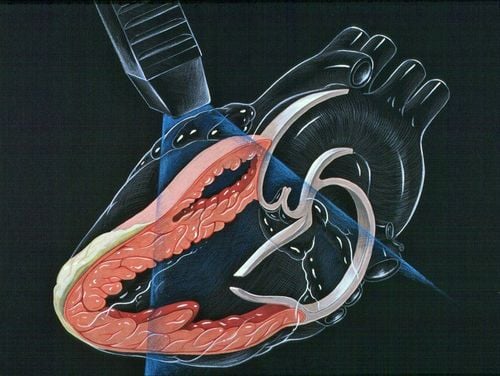This is an automatically translated article.
Tetralogy of Fallot is considered one of the most common congenital heart disease with cyanosis in clinical practice, the disease is very dangerous to the patient's life and is accompanied by other abnormalities in the body besides the cardiovascular system. To confirm the diagnosis of Tetralogy of Fallot, it is necessary to combine both clinical examination and some laboratory tests, the most important of which is echocardiography.
1. Tetralogy of Fallot
Tetralogy of Fallot is one of the common congenital heart diseases, accounting for about 10% and often presenting with symptoms of non-cardiac damage. Tetralogy of Fallot is often associated with a number of conditions such as fetal alcohol syndrome, trisomy 21 syndrome, Goldenhar syndrome and some other health problems related to genetic factors. The tetralogy of Fallot consists of four prominent features: pulmonary outlet stenosis, ventricular septal defect, right equine or displaced aorta and right ventricular hypertrophy. In which, pulmonary artery outlet stenosis along with ventricular septal defect are the two most important syndromes for tetralogy of Fallot.
Pulmonary outlet stenosis usually narrows the funnel, can be long or short, high or low in individual cases, some can have pulmonary stenosis or stenosis of the upper part of the valve accompanying lungs. As for the ventricular septal defect in tetralogy of Fallot, the foramen is usually relatively wide, limited to the border of the inferior Wolf's spur muscle. These are the two most important conditions to watch out for in tetralogy of Fallot because they can lead to an increased risk of right ventricular hypertrophy. In addition, a number of medical conditions may be associated with tetralogy of Fallot including:
Right aorta Pulmonary stenosis Pulmonary septal defect ventricular septal defect in coordinating muscle collateral Circulation of the aorta and pulmonary artery Anomalies of the coronary arteries Pulmonary hypoplasia with multiple collateral circulation.

Tứ chứng Fallot là một trong những bệnh lý tim bẩm sinh thường gặp
Regarding the pathophysiology of tetralogy of Fallot, when the pulmonary artery is narrowed, the blood flow will be obstructed, leading to the formation of a systolic murmur at the pulmonary valve, increasing the right heart load. The appearance of a ventricular septal defect allows blood to escape into the large circulation of the body, causing problems with pulmonary stenosis as well as obstruction to the great circulation.
As a result, blood flow obstructions to the right ventricular outflow tract increase with time, and with it, the resistance to the great circulation decreases, so the shunt flows from right to left, reducing away the saturation of oxygen for the large circulation of the body. The end result is that the patient will develop cyanosis very soon, along with the increasing dilation of the pulmonary arteries in patients with severe pulmonary stenosis.
Some clinical symptoms of patients with tetralogy of Fallot are:
Cyanosis of the skin and mucous membranes when reduced movement, not certain, increased more when the patient exercised or when the body encountered cold. There can be paroxysmal heart attacks accompanied by some dangerous symptoms such as apnea, fainting, convulsions, neurological symptoms and can lead to death later. Squat sign Drumstick finger impression 3 to 5 systolic murmur, heard in the left 2nd to 4th intercostal space for strong T2 or split T2 sternum Continuous murmur below the clavicle or region patient's back.

Người bệnh cần nắm rõ các triệu chứng lâm sàng để sớm phát hiện tứ chứng Fallot
2. Congenital echocardiography
Besides the clinical symptoms, the paraclinical tools also support the diagnosis and treatment of tetralogy of Fallot a lot, such as chest x-ray, electrocardiogram and echocardiography. In particular, echocardiography is an imaging method of great value in diagnosing and finding the causes of clinical symptoms of tetralogy of Fallot.
Some of the main goals for congenital echocardiography in general and the diagnosis of tetralogy of Fallot in particular include:
Assess the location and extent of the ventricular septal defect Investigate the characteristics and status of airway obstruction right ventricular outflow, especially in locations where this condition is common, such as the valve, funnel, or middle part of the right ventricle. Assess the size and abnormalities of the pulmonary artery. Investigate the coronary artery route as well as the correspondence between the coronary artery and the right ventricular funnel Determine the location of the aortic arch and its branches from the aortic arch Measure the size of the heart chambers Evaluate function left ventricular systole Investigate the thickness of the heart wall, especially the wall of the right ventricle. Look for associated lesions, if any. In echocardiography to diagnose congenital heart disease, there are 2 types of ultrasound widely used today:
2D ultrasound: Perform cardiac exploration with 4 main cross-sections: longitudinal axis left sternal edge, transverse axis left sternal edge, suprasternal depression, and substernal surface.
When performing 2D ultrasound, it will often detect pathological conditions such as wide ventricular septal defect spreading to the funnel, equestrian aorta, dilated ascending aorta...

Siêu âm 2D là thực hiện thăm dò tim với 4 mặt cắt chính
Continuous Doppler ultrasound: Continuous Doppler ultrasound in the congenital heart allows measurement of the pressure difference in the narrow locations at the funnel or the pressure difference between the right ventricle and the pulmonary artery.
Some pathological conditions can be observed through this echocardiogram method, which is the phenomenon of wide and high periventricular septal defect, the aorta riding up the interventricular septum, detecting associated lesions. according to atrial septal defect or ventricular septal defect along with other associated malformations.
3. Conclusion
Tetralogy of Fallot is a common congenital heart disease in clinical practice, including lesions in the heart or may be accompanied by other abnormalities outside the heart. Congenital echocardiography is considered an extremely effective diagnostic aid because it allows to investigate abnormalities in the structures of the heart as well as the thorax around the heart, thereby finding out abnormalities in the pathology and have the most effective treatment for the patient.
To protect cardiovascular health in general and detect early signs of myocardial infarction and stroke, customers can sign up for Cardiovascular Screening Package - Basic Cardiovascular Examination of Vinmec International General Hospital . The examination package helps to detect cardiovascular problems at the earliest through tests and modern imaging methods. The package is for all ages, genders and is especially essential for people with risk factors for cardiovascular disease.
Please dial HOTLINE for more information or register for an appointment HERE. Download MyVinmec app to make appointments faster and to manage your bookings easily.













